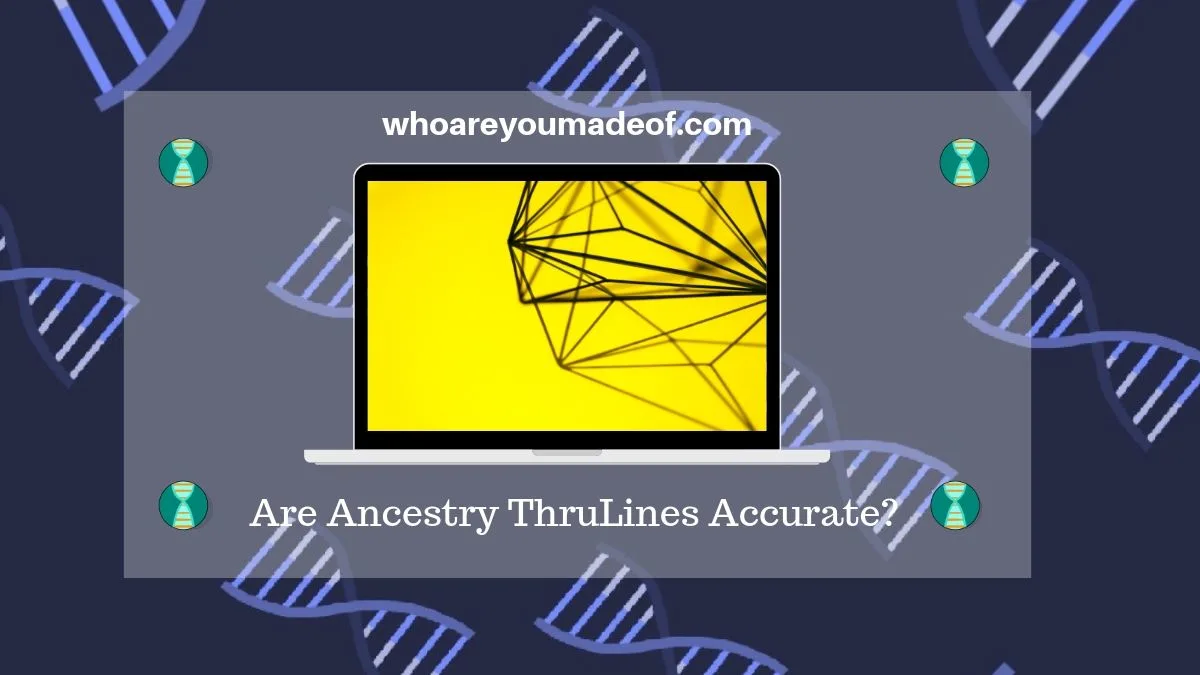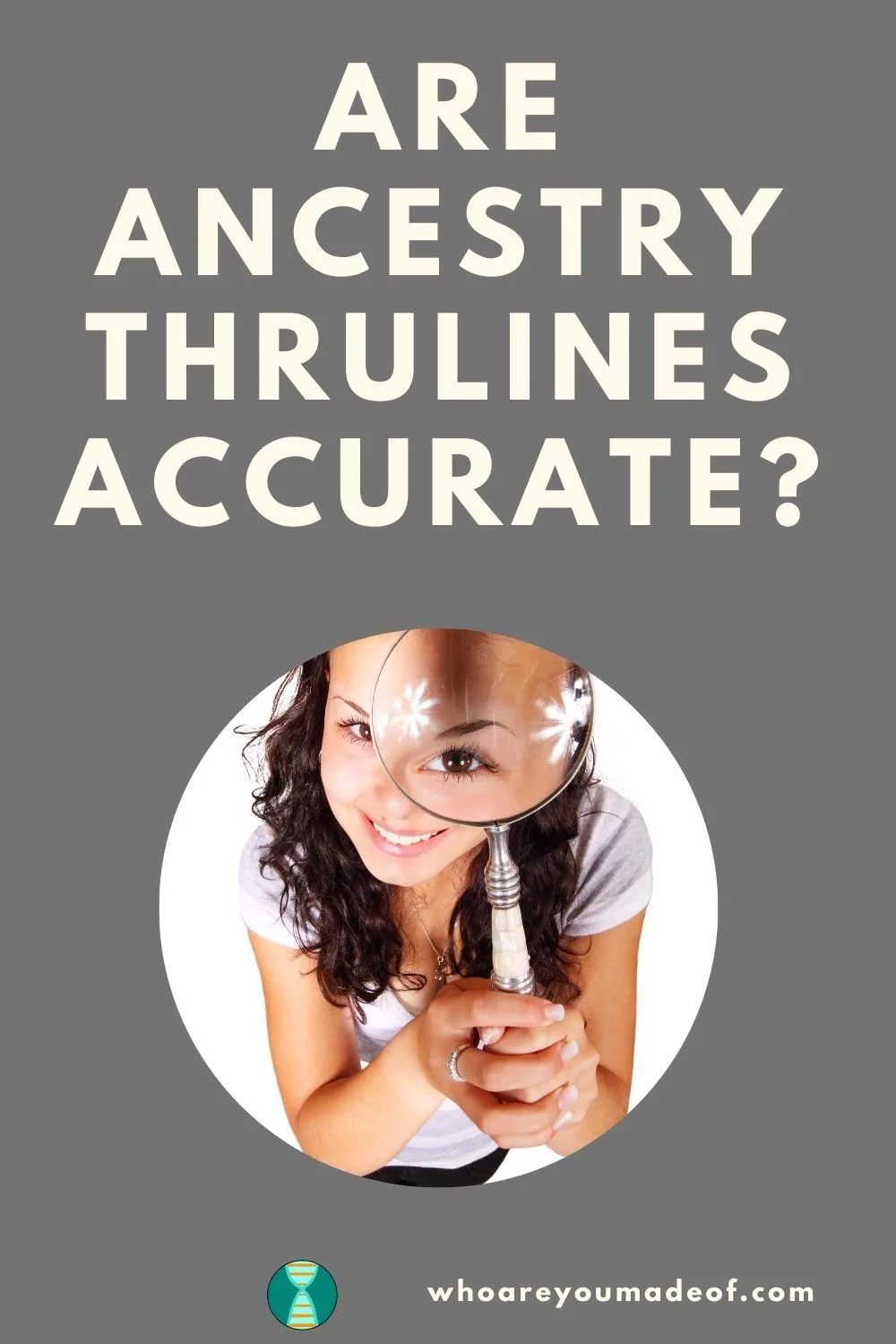If you did an Ancestry DNA test, you have access ThruLines, which are a great way to learn how your DNA matches may be related and to learn more about your family tree. Are Ancestry ThruLines accurate, however?
In this post, learn about the accuracy of Ancestry DNA ThruLines, as well as:
- How to tell whether your ThruLines are accurate
- How to make sure the information you learn from your ThruLines doesn't lead you astray

This article primarily addresses the accuracy of Ancestry ThruLines. If you aren't familiar with Ancestry DNA ThruLines, I recommend the following two articles that can help you learn more about this Ancestry feature:
I have found Ancestry ThruLines to be a fun way to explore my DNA results and learn more about my heritage. I hope that this post helps you understand more about the accuracy of this tool so you can do the same.
Are Ancestry ThruLines accurate?
Even though Ancestry DNA ThruLines are generally accurate, they should be viewed as a helpful way to guide our research. We should view ThruLines with the same discerning perspective that we would examine a public family tree.
Most of my ThruLines, about 90%, are as accurate as I could expect them to be, based on what I know about my family tree from DNA and genealogical research.
ThruLines are based on family tree information
Ancestry DNA ThruLines are based on information from the family trees of your DNA matches and other Ancestry members, even those who have not done DNA tests. The ThruLines feature is an excellent way to examine large quantities of family tree data, taking into account DNA matches along the way.
This technological feat is something that only computer software could do quickly and thoroughly. It would take entirely too long for an individual person to examine all of the information computed for a ThruLine line-by-line.
If the family trees used in the ThruLine is incorrect, and lots of people have the same incorrect information in their tree, the ThruLine has the potential to be incorrect, too.
For example, I know that my grandparent's grandmother got married when she was pregnant with another man's child. It was one of those weddings that occurred only a month or so before the birth of the child.
A daughter was born, and she was given the surname of her mother's husband.
This daughter was a half-aunt to one of my grandparents. I'm not sure if my grandparent knew it at the time, but it is clear from the amount of DNA that my grandparent's brother shares with certain DNA matches that this was definitely a "half" aunt.
When I look at the ThruLine for my grandparent's grandfather, who was the step-father of Ruth, the half-aunt, she shows appears. The ThruLine suggests, via a dotted line, that she and her descendants are related to me through this male ancestor.
The problem is that other family members - including her descendants - are unaware of Ruth's biological origins. Since the majority of people in this line of my family tree have an incorrect father identified for Ruth, the ThruLine displays Ruth's descendants (my DNA matches) as possible descendants of Ruth's step-father.
If I didn't know better, I might view the fact that I am DNA-matched to Ruth's descendants as evidence that I am descended from the step-father.
Of course, I know that he was not her biological father. I have since found old family documents suggesting the name of her true biological father and I have added it to my tree.
In the case of this example, the "consequences" are not grave. We are discussing genealogy and I always advise that we are in this together to have fun!
It's easy to imagine that there are other cases where "confirmation bias" in genealogy has caused incorrect ThruLines to pop up. We humans are vulnerable to this, and even though technology is arguably more objective, it is not immune.
How to know if your Ancestry DNA ThruLines are accurate?
Fortunately, there are several steps you can take to verify the accuracy of your ThruLines to make sure that you are using the feature to your advantage.
Examine each ThruLine individually
It is important to take the time to individually examine each Ancestry ThruLine. You might find that there is no new information included in some of your ThruLines.
For example, I have lots of ThruLines for some of my more distant who don't have any descendants who are connected to me through DNA. It's possible that in the future DNA matches will show up to change the ThruLines, however.
In the image below, you can see a ThruLine for my 5th great-grandfather, Thomas. Thomas has a ThruLine, but there are no DNA matches who show up as connected to me through him, or through his son, Samuel.

I could interpret this in a few different ways. Am I really descended from Samuel and Thomas, or do I just have few DNA matches who have also tested on Ancestry who are related on this line of my family?
Check out the amount of DNA that you share with DNA matches that show up on the ThruLine
You should always examine the amount of DNA that you share with your DNA matches that show up on ThruLines for a particular ancestor. The top reason for checking this is because we can be related to our DNA matches in more than one way.
Take, for example, a DNA match that that shares 112 centimorgans with you across 6 segments. On the ThruLines, it shows your common ancestor as your 6th great-grandparents. This would make you seventh cousins!
Someone who shares 112 centimorgans with you is definitely related to you more closely than 7th cousin, or is related to you in more than one way. And one of those ways is likely closely than seventh cousin.
This should lead you to closely examine the family tree of your DNA match to spot other ways in which you may be connected. You are likely to learn something new about your family tree through this process.
To learn more about centimorgans and DNA shared for different relationship distances, you might be interested in checking out the following links:
- Beginner's Guide to Shared Centimorgans
- Shared cM Project 3.0 (calculator for determining relationship possibilities)
Find documents and records verifying new or contradictory information from ThruLines
To verify a new, potential ancestor, or even information that contradicts what is currently in your family tree, you will need to employ some basic genealogical sleuthing skills.
If you see something interesting in your ThruLines, try to find alternate sources that can help you verify - or disprove - the ThruLine:
- Birth, death, marriage records
- Census records
- Historical documents (like newspapers and stories)
- Family bibles and oral stories
Building a family tree is like building a case of evidence to prove a theory. ThruLines are one piece of evidence that can be used to help you in your family tree detective work.

Conclusion
I hope that this post has helped you understand more about the accuracy of your Ancestry DNA ThruLines, and how to verify the information on your ThruLines on your own.
If you have any questions about something that you read in this post, or if you would like to share your own positive experience with Ancestry ThruLines, I would love to hear from you in the discussion below.
Thank you for stopping by today!


Naomi Fron
Sunday 28th of January 2024
I believe that my maternal grandfather was a NPE (as I am). When I had his accepted father in my tree, there were no DNA matches in any of the ancestors that were in ThruLines. I had over 400 DNA matches that I was unable to connect to, but when I replaced my grandfather's father with a man that I believed to be his birth father, all 400+ DNA matches lined up. I can't prove it with documentation (fooling around in the old days did not carry a paper trail), but I see no other way that I match all of those people. If it were one or two, I would think maybe, but over 400..... Anyway, that's my story regarding ThruLines.
Joseph Filip
Monday 9th of August 2021
This post confirms my suspicions about how the ThruLines toll works. It is usually great. I have 2 major cases where the "preponderence of information" is incorrect. I'll use one example. Other researchers believe that Karel was the son of one of my 3X great aunts. I found all of her 8 children in the 1800s in the Czech archives. But people are assigning a 9th child to her, born 4 months before a known, confirmed child. I have also found the outlier's birth record, and Karel was her nephew! It is so far back that the cM count is within normal range either way. As I'm sure you know, it is futile to try to convince even one person to correct an error like this. And all of the copycat trees made by dabblers- many of them are no longer active at all. Is there no way to "force" ThruLines to accept my OWN Tree as correct insofar as it goes before it starts trying to make connections at the loose ends?
Mercedes
Friday 13th of August 2021
Hi Joseph, The story from your family tree is an excellent example of why we really need to carefully examine each ThruLine, just as we would any genealogical document or other evidence that we would consider using to build our family tree. I don't know of any way that we can teach the algorithm that OUR tree is correct, other than encouraging other people who are related on those lines to add the correct line to their tree. It's hard to get people to change details that they have already added to their trees, but perhaps other descendants of your fourth-great grandparents who have not build a "wide" tree, as we know that we should, could be persuaded to add some of these other relatives. Thank you for your comment, and the reminder to double-check these ThruLines.